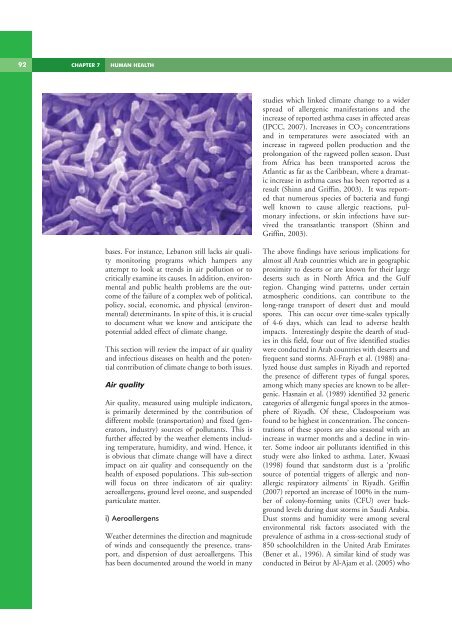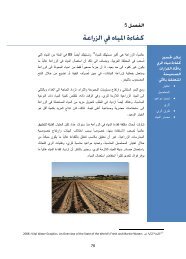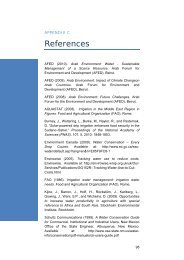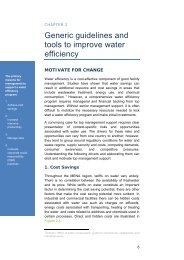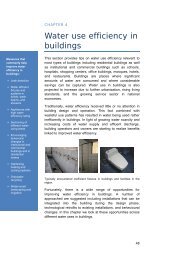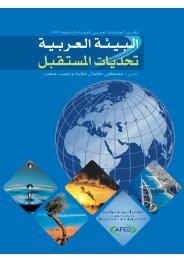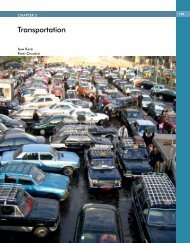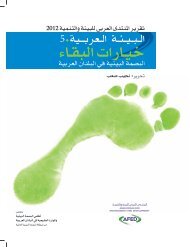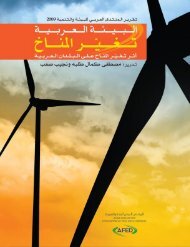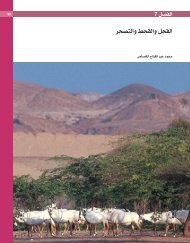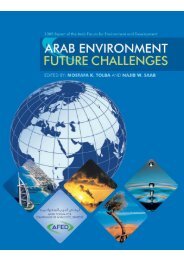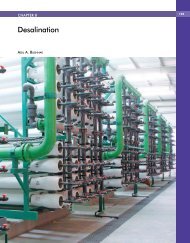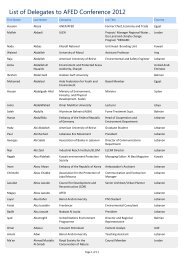Impact of Climate Change on Arab Countries - (IPCC) - Working ...
Impact of Climate Change on Arab Countries - (IPCC) - Working ...
Impact of Climate Change on Arab Countries - (IPCC) - Working ...
You also want an ePaper? Increase the reach of your titles
YUMPU automatically turns print PDFs into web optimized ePapers that Google loves.
92<br />
CHAPTER 7<br />
HUMAN HEALTH<br />
studies which linked climate change to a wider<br />
spread <str<strong>on</strong>g>of</str<strong>on</strong>g> allergenic manifestati<strong>on</strong>s and the<br />
increase <str<strong>on</strong>g>of</str<strong>on</strong>g> reported asthma cases in affected areas<br />
(<strong>IPCC</strong>, 2007). Increases in CO 2 c<strong>on</strong>centrati<strong>on</strong>s<br />
and in temperatures were associated with an<br />
increase in ragweed pollen producti<strong>on</strong> and the<br />
prol<strong>on</strong>gati<strong>on</strong> <str<strong>on</strong>g>of</str<strong>on</strong>g> the ragweed pollen seas<strong>on</strong>. Dust<br />
from Africa has been transported across the<br />
Atlantic as far as the Caribbean, where a dramatic<br />
increase in asthma cases has been reported as a<br />
result (Shinn and Griffin, 2003). It was reported<br />
that numerous species <str<strong>on</strong>g>of</str<strong>on</strong>g> bacteria and fungi<br />
well known to cause allergic reacti<strong>on</strong>s, pulm<strong>on</strong>ary<br />
infecti<strong>on</strong>s, or skin infecti<strong>on</strong>s have survived<br />
the transatlantic transport (Shinn and<br />
Griffin, 2003).<br />
bases. For instance, Leban<strong>on</strong> still lacks air quality<br />
m<strong>on</strong>itoring programs which hampers any<br />
attempt to look at trends in air polluti<strong>on</strong> or to<br />
critically examine its causes. In additi<strong>on</strong>, envir<strong>on</strong>mental<br />
and public health problems are the outcome<br />
<str<strong>on</strong>g>of</str<strong>on</strong>g> the failure <str<strong>on</strong>g>of</str<strong>on</strong>g> a complex web <str<strong>on</strong>g>of</str<strong>on</strong>g> political,<br />
policy, social, ec<strong>on</strong>omic, and physical (envir<strong>on</strong>mental)<br />
determinants. In spite <str<strong>on</strong>g>of</str<strong>on</strong>g> this, it is crucial<br />
to document what we know and anticipate the<br />
potential added effect <str<strong>on</strong>g>of</str<strong>on</strong>g> climate change.<br />
This secti<strong>on</strong> will review the impact <str<strong>on</strong>g>of</str<strong>on</strong>g> air quality<br />
and infectious diseases <strong>on</strong> health and the potential<br />
c<strong>on</strong>tributi<strong>on</strong> <str<strong>on</strong>g>of</str<strong>on</strong>g> climate change to both issues.<br />
Air quality<br />
Air quality, measured using multiple indicators,<br />
is primarily determined by the c<strong>on</strong>tributi<strong>on</strong> <str<strong>on</strong>g>of</str<strong>on</strong>g><br />
different mobile (transportati<strong>on</strong>) and fixed (generators,<br />
industry) sources <str<strong>on</strong>g>of</str<strong>on</strong>g> pollutants. This is<br />
further affected by the weather elements including<br />
temperature, humidity, and wind. Hence, it<br />
is obvious that climate change will have a direct<br />
impact <strong>on</strong> air quality and c<strong>on</strong>sequently <strong>on</strong> the<br />
health <str<strong>on</strong>g>of</str<strong>on</strong>g> exposed populati<strong>on</strong>s. This sub-secti<strong>on</strong><br />
will focus <strong>on</strong> three indicators <str<strong>on</strong>g>of</str<strong>on</strong>g> air quality:<br />
aeroallergens, ground level oz<strong>on</strong>e, and suspended<br />
particulate matter.<br />
i) Aeroallergens<br />
Weather determines the directi<strong>on</strong> and magnitude<br />
<str<strong>on</strong>g>of</str<strong>on</strong>g> winds and c<strong>on</strong>sequently the presence, transport,<br />
and dispersi<strong>on</strong> <str<strong>on</strong>g>of</str<strong>on</strong>g> dust aeroallergens. This<br />
has been documented around the world in many<br />
The above findings have serious implicati<strong>on</strong>s for<br />
almost all <strong>Arab</strong> countries which are in geographic<br />
proximity to deserts or are known for their large<br />
deserts such as in North Africa and the Gulf<br />
regi<strong>on</strong>. Changing wind patterns, under certain<br />
atmospheric c<strong>on</strong>diti<strong>on</strong>s, can c<strong>on</strong>tribute to the<br />
l<strong>on</strong>g-range transport <str<strong>on</strong>g>of</str<strong>on</strong>g> desert dust and mould<br />
spores. This can occur over time-scales typically<br />
<str<strong>on</strong>g>of</str<strong>on</strong>g> 4-6 days, which can lead to adverse health<br />
impacts. Interestingly despite the dearth <str<strong>on</strong>g>of</str<strong>on</strong>g> studies<br />
in this field, four out <str<strong>on</strong>g>of</str<strong>on</strong>g> five identified studies<br />
were c<strong>on</strong>ducted in <strong>Arab</strong> countries with deserts and<br />
frequent sand storms. Al-Frayh et al. (1988) analyzed<br />
house dust samples in Riyadh and reported<br />
the presence <str<strong>on</strong>g>of</str<strong>on</strong>g> different types <str<strong>on</strong>g>of</str<strong>on</strong>g> fungal spores,<br />
am<strong>on</strong>g which many species are known to be allergenic.<br />
Hasnain et al. (1989) identified 32 generic<br />
categories <str<strong>on</strong>g>of</str<strong>on</strong>g> allergenic fungal spores in the atmosphere<br />
<str<strong>on</strong>g>of</str<strong>on</strong>g> Riyadh. Of these, Cladosporium was<br />
found to be highest in c<strong>on</strong>centrati<strong>on</strong>. The c<strong>on</strong>centrati<strong>on</strong>s<br />
<str<strong>on</strong>g>of</str<strong>on</strong>g> these spores are also seas<strong>on</strong>al with an<br />
increase in warmer m<strong>on</strong>ths and a decline in winter.<br />
Some indoor air pollutants identified in this<br />
study were also linked to asthma. Later, Kwaasi<br />
(1998) found that sandstorm dust is a ‘prolific<br />
source <str<strong>on</strong>g>of</str<strong>on</strong>g> potential triggers <str<strong>on</strong>g>of</str<strong>on</strong>g> allergic and n<strong>on</strong>allergic<br />
respiratory ailments’ in Riyadh. Griffin<br />
(2007) reported an increase <str<strong>on</strong>g>of</str<strong>on</strong>g> 100% in the number<br />
<str<strong>on</strong>g>of</str<strong>on</strong>g> col<strong>on</strong>y-forming units (CFU) over background<br />
levels during dust storms in Saudi <strong>Arab</strong>ia.<br />
Dust storms and humidity were am<strong>on</strong>g several<br />
envir<strong>on</strong>mental risk factors associated with the<br />
prevalence <str<strong>on</strong>g>of</str<strong>on</strong>g> asthma in a cross-secti<strong>on</strong>al study <str<strong>on</strong>g>of</str<strong>on</strong>g><br />
850 schoolchildren in the United <strong>Arab</strong> Emirates<br />
(Bener et al., 1996). A similar kind <str<strong>on</strong>g>of</str<strong>on</strong>g> study was<br />
c<strong>on</strong>ducted in Beirut by Al-Ajam et al. (2005) who


